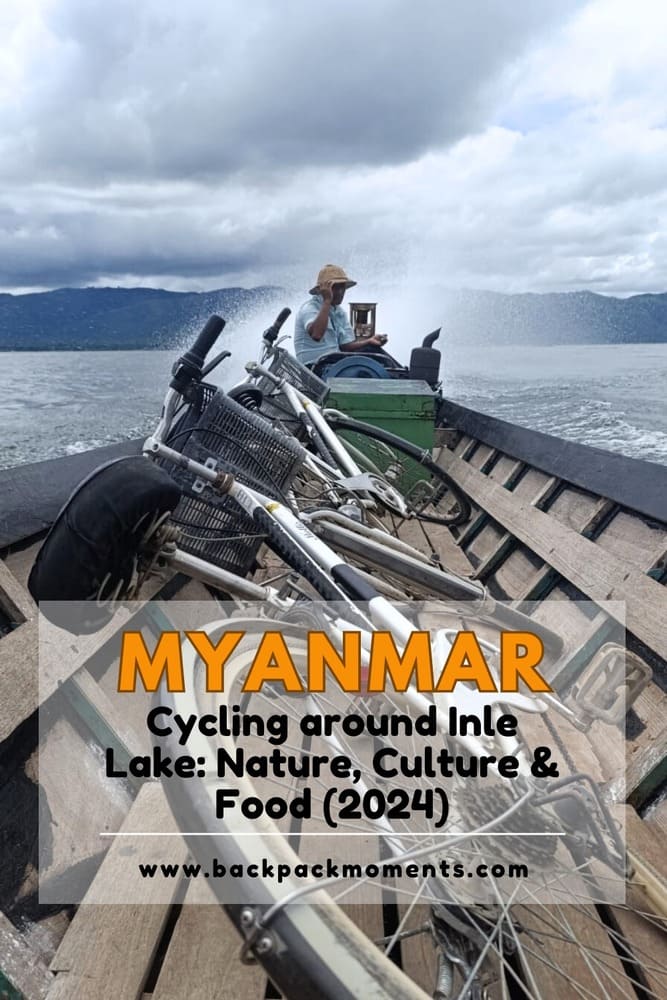Cycling around Inle Lake: Nature, Culture & Food
This post may contain affiliate links. If you make a purchase using one of these links, I may receive a small reward at no extra cost to you. See my Disclosure Policy for more information.
Inle Lake is an almost mythical place in Myanmar. Picturesque, diverse (in all aspects), and remote, it is easily a synecdoche for all of Myanmar. A miniature representation of its beauty and heterogeneity.
No trip to Myanmar is truly complete before a visit to Inle Lake.
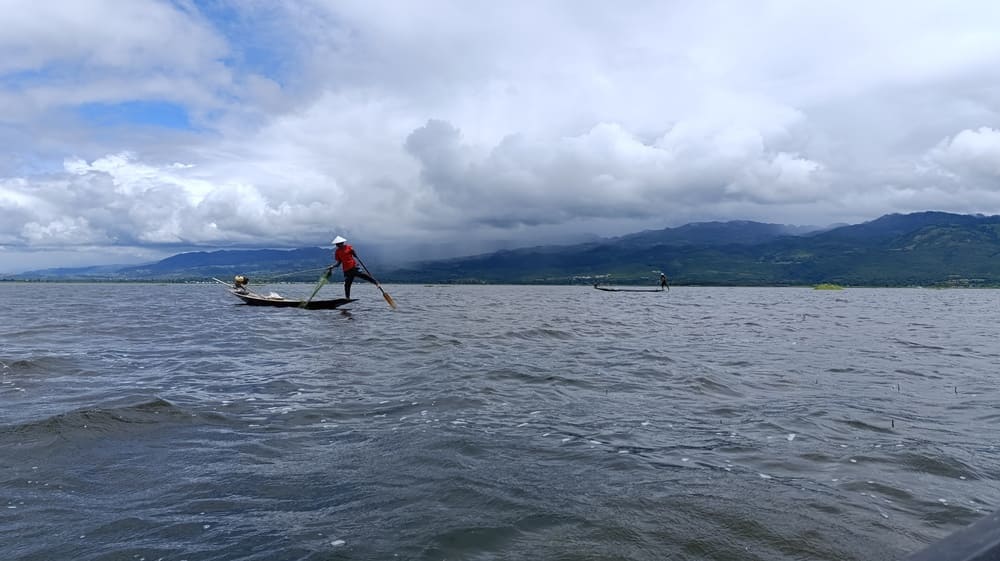
There are 2 ways to explore Inle Lake:
- By a boat tour. It will take you around the lake, water-bound from village to village, from one side of the lake to the other.
- By bicycle + boat. Cycle through the various villages around Inle Lake, then cross by boat and return to where you started from the other side (where more excitement awaits).
Both have their merits. I chose to cycle around Inle Lake. Here’s what I experienced and how you can plan your trip there too.
Begin in Nyaung Shwe
The gateway to Inle Lake is the small town of Nyaung Shwe. It’s just 5 km from the lakeshore and connected to it by a canal. Not to be mistaken with Shwenyaung, which is 12 km north, next to the train stop and on the main road.
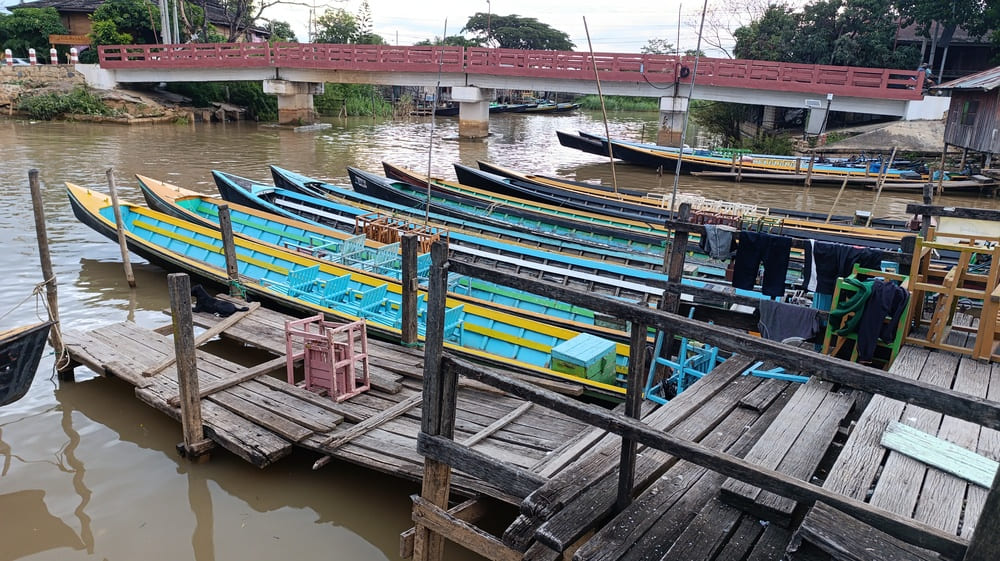
When I visited Myanmar in late July 2024, Nyaung Shwe was in its 4th year of no tourism. First the COVID pandemic, then the civil war. Many hotels, restaurants, and travel agents had closed – whether permanently or temporarily remains to be seen.
Depending on when you’re reading this, Nyaung Shwe may still be a quiet rural town or a buzzing tourism hotspot. I experienced the former and despite many places being inaccessible, I don’t think I would trade it for the latter.
Rent a bicycle
Cycling around Inle Lake is a popular activity and hotels usually have bicycles for rent. If not, walk along one of the streets in the center of town and ask around. One of the travel agents is bound to have some.
The bicycles are usually shabby and old. Thankfully, the roads around Inle Lake are not too bad and don’t require a special bike. A standard, single-gear bicycle will do the job just fine.
A 1-day bicycle rental cost 2000 MMK (~0.4$ when I was there), although with the crazy inflation going on, this will certainly change. Learn more about how to handle money in Myanmar.

Recommended cycling route
Depending on your fitness level, you can choose to go as far south as Inthein from Nyaung Shwe (~30 km) before crossing the lake by boat.
But not everybody can cycle 70+ kilometers in one day, especially on somewhat shabby bikes. So, I will share with you a shorter itinerary, which gets you from Nyaung Shwe to Kaung Daing, crossing Inle Lake and going back the other way. In total, around 30 kilometers.
Part 1: Cycling from Nyaung Shwe to Kaung Daing
As you cross the bridge on the west side of Nyaung Shwe and continue cycling along the road, look to your left. Endless rice fields of perfectly evened greenery separated by small streams of water and the occasional local working in the field.
Idyllic.
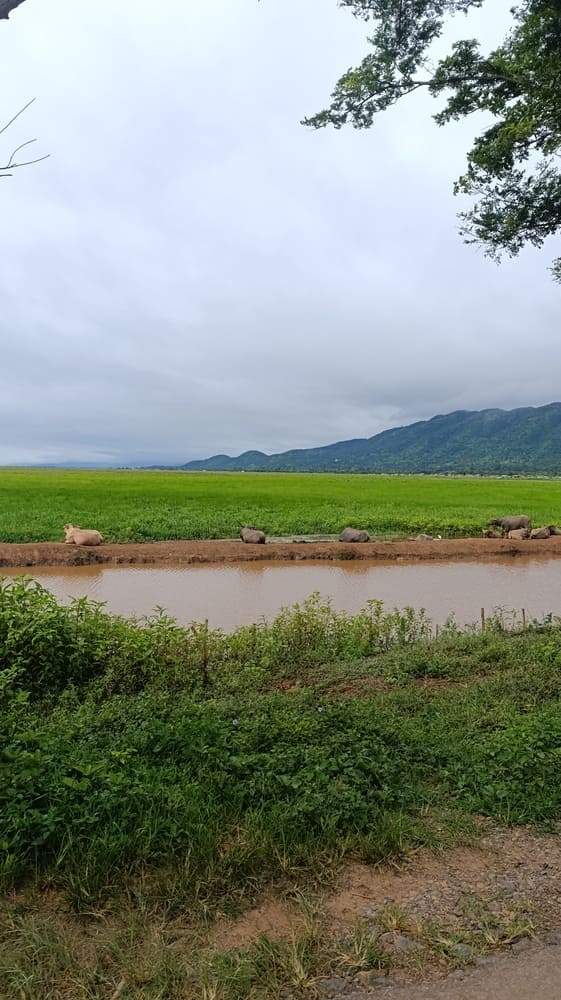
About 5 km the road turns left and there is a military checkpoint. The guys (and yes, a lot of the Junta soldiers are just guys – young, green, and inexperienced) just waved us through without any questions, even though we were probably the only tourists in the past few months.
The Natural Hot Springs
Another 4 km after the turn and you will arrive at the Khaung Daing Hot Springs.
When tourism inevitably picks up again in Myanmar, these will be a popular place to relax and loosen the muscles. Now they were almost derelict. Just 2 local Burmese taking a bath. I am not sure if the water was even hot.
No tickets were being sold, although I’ve heard that foreigners had to pay 10$ to enter before the Pandemic.
You will notice a sad trend in this guide – many of the places around Inle Lake had closed. This is one reason why the ethics of traveling to Myanmar are not so clear-cut to me.
Inn Oo Ancient Pagoda
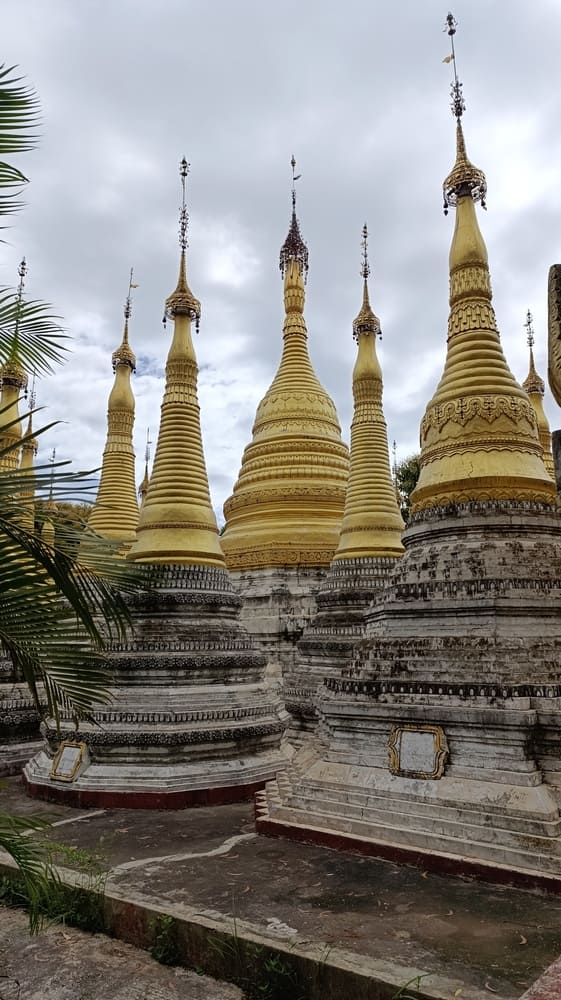
Inn Oo is a famous place in Myanmar and locals come on a pilgrimage from all over the country.
Hundreds of small stupas over a small area, each of which just a little bit different from the rest. Some gilded with gold, some have their brick layers exposed. It looks timeless.
Mr Yam’s Food Tour in Kaung Daing

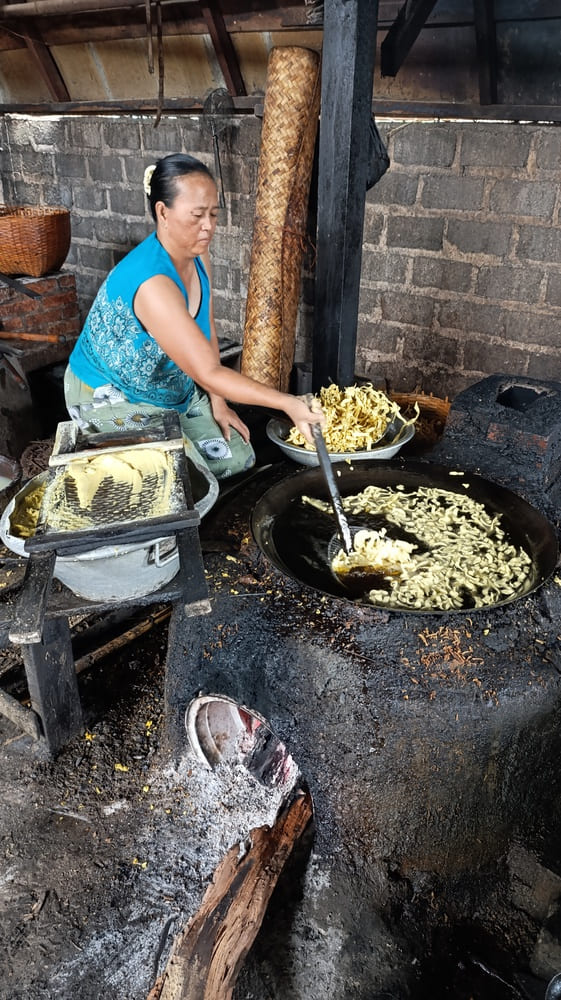
Arriving at Kaung Daing, you may think there is nothing to do there. A small Burmese village with hard-working people. Little do you know that it’s the highlight of this self-guided cycling tour around Inle Lake.
Look for “The Tofu House” on Maps.me. Ask for Mr. Yam. He will be there somewhere.
He was surprised to see foreigners. He hadn’t seen any for months. He runs an impromptu food tour in Kaung Daing and before the pandemic, hundreds would come and learn about the making of different snacks in the village. Despite his unpreparedness, he quickly agreed to tour us around.
If Southeast Asia has taught me something, it is to agree on a price before using any service. As much as it’s an unpleasant part of interacting with locals, it is also a way to avoid even more unpleasant situations afterwards. We agreed on a price of 40.000 MMK (~8.5 USD on the black market) for the food tour + a boat ride across Inle Lake.
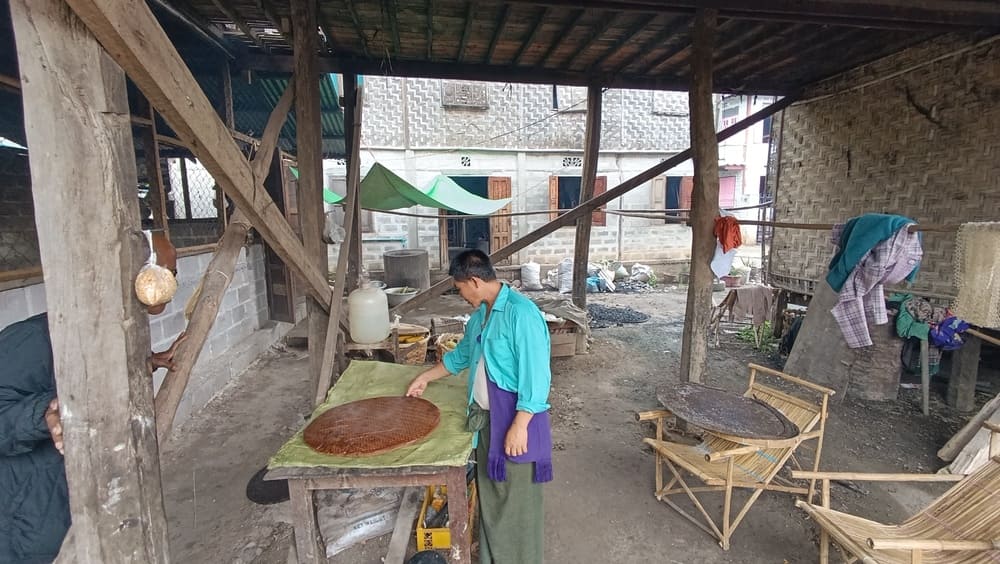
Mr. Yam is kind, knowledgeable, and has big dreams for his community. He wants Kaung Daing to see more foreigners but retain its rural charm and authentic way of life. I hope he succeeds.
He took us around the village getting us inside houses where the locals were cooking all sorts of snacks, desserts, food, growing vegetables, even distilling moonshine.


We bought freshly baked peanuts and snacks directly from the vendors. At the end of the tour, we got to try the famous fried tofu which gives the name to the Tofu House. Delicious.
I totally recommend everybody meet Mr Yam and let him tour you around his village. It’s an authentic experience like no other in the region.
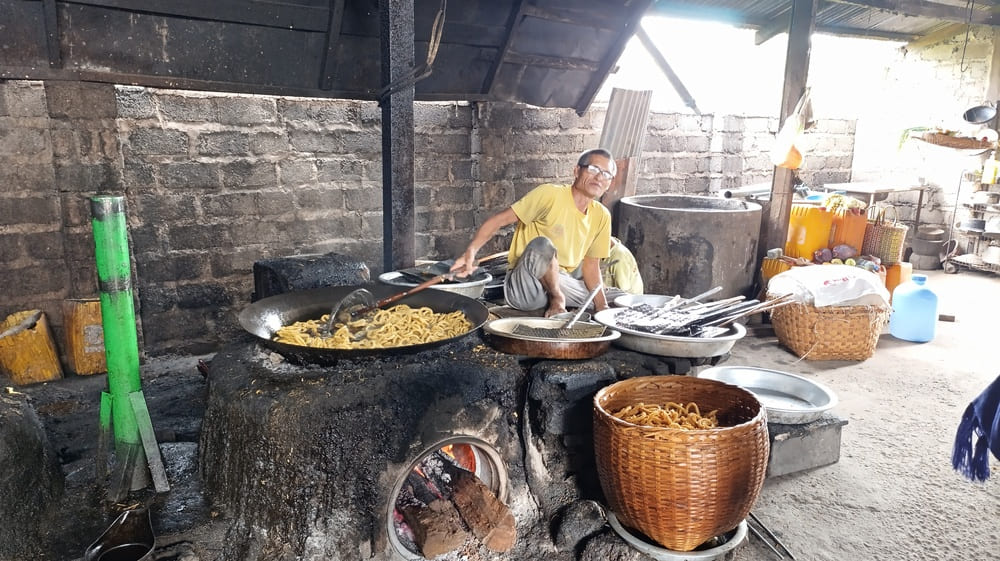
20% chance of catching the 5-day market
There is a market somewhere around Inle Lake every day. It rotates between the bigger villages around the Lake (Kaung Daing is one of them), which means that every 5 days, the 5-day market is in Kaung Daing.
Those who opt to go by boat and explore all of Inle Lake will certainly see the market somewhere around the lake. The locals know where it is; your boat driver will bring you to it.
But if you don’t and just turn up at Kaung Daing, there is a 20% chance it’s there.
Unfortunately, we missed it by 1 day and when we arrived, the market was on the other side of the lake.
Boat ride to the other side of Inle Lake

It was time to cross the lake. Mr Yam brought us to his friends, who were waiting for passengers to take across the boat. I don’t think they had many “customers” so they were pretty happy to see foreigners and get some business.
If you don’t meet Mr. Yam, just walk towards the lake and you will inadvertently see them. You can negotiate a boat passage or a whole tour. The going rate to just cross the lake is 20.000 MMK (~4$ on the black market rate when I was there) per boat including the bicycles.
The boat ride should take around 20 minutes with the driver stopping the engine for a few minutes in the middle of the lake to enjoy the serenity, observe the Inle Lake fishermen, and take pictures.
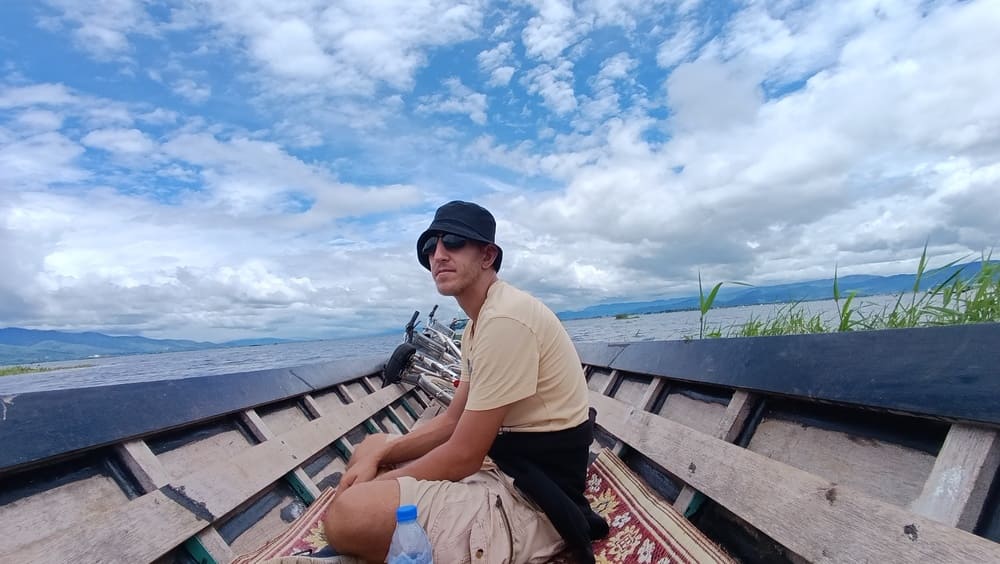
Our short stop turned into a 1-hour near-disaster as the engine wouldn’t start again despite continuous efforts. It wasn’t scary, no – the boat was stable and there were barely any waves. The nearby fishermen would help if push came to shove.
It was actually a lucky moment that allowed us to stand quietly in the middle of the lake and enjoy the scenery.
The driver had to call some friends to aid him. Mr Yam and the other boat driver came, fixed the boat and we continued on our way.
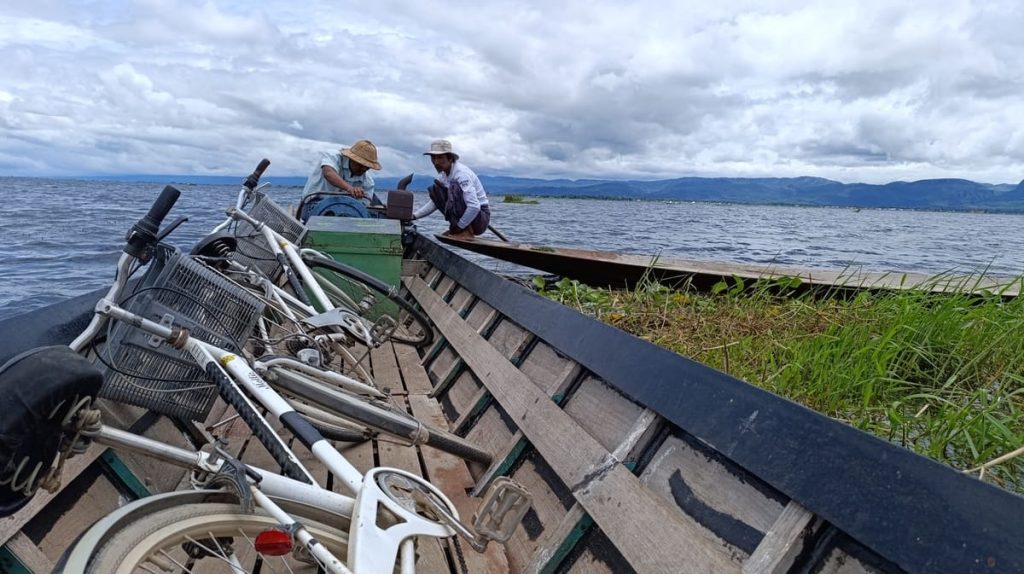
Part 2: Cycling from Maing Thauk back to Nyaung Shwe
On the other side of the lake, you have the option to stop for lunch at one of the restaurants on stilts. Simply call/wave at the restauranteur and he/she will come to pick you up with a boat. There is no way to walk over to most of them.
We were full after all the snacks and the tofu from Mr. Yam’s food tour, so went past the eateries.
Mine Thauk Wooden Bridge
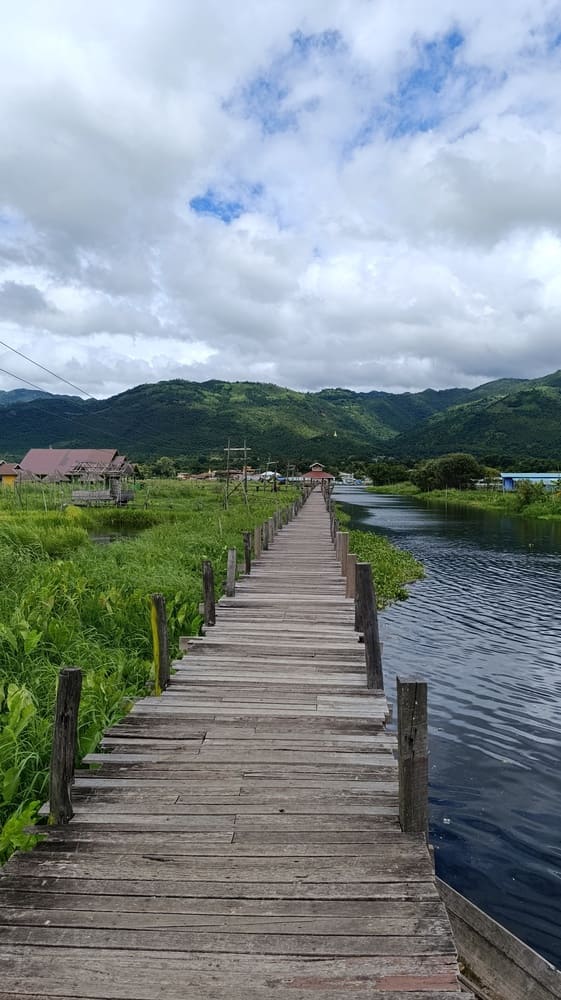
The bridge is 500 meters long with multiple pavilions along the way. On both sides are either people’s houses or water farms.
It’s a pretty place with lots of opportunities for pictures.
Local vendors sell fruits and nuts inside the pavilions and at the end of the bridge.

Mine Thauk Monastery and Viewpoint
Instead of turning left on the main road back towards Nyaung Shwe, continue straight for 2.5 km until reaching the Mine Thauk Buddhist Monastery.
The road slopes up and if your bicycle is one of the old ones with just 1 gear, you may have to push it uphill (this pays off later when you go down with the wind in your hair). There are awesome views towards Inle Lake from the Monastery.
The Monastery, as much as I have respect for all Buddhist places of meditation (not worship, there is no worship in Buddhism), is not much different from any of the other 30+ you may have already seen in Myanmar.
It is perhaps important to interject here and talk about monkhood in Myanmar for a second. Everybody is expected to become a monk for a while. In this regard, it’s similar to military service in some countries, though, of course, Buddhist monkhood is totally opposite in purpose and symbolism.
Mr. Yam told us he was a monk for 3 years. Back in his days, being a monk for 2-3 years was the norm. Today, he says, young people don’t want that life. It’s a life of limitations and simplicity. Often, they only go to the monastery for a few weeks and then leave to pursue something else.
Orphans, on the other hand, don’t have the luxury of choice, so they make up the bulk of kids staying in Buddhist monasteries long term.
In Myanmar, both men and women can become monks. Men (wearing orange or brownish robes) are called bhikku while women (whom you may recognize by the pink robes) are called bhikkhuni.
Locks of Love Community Cafe
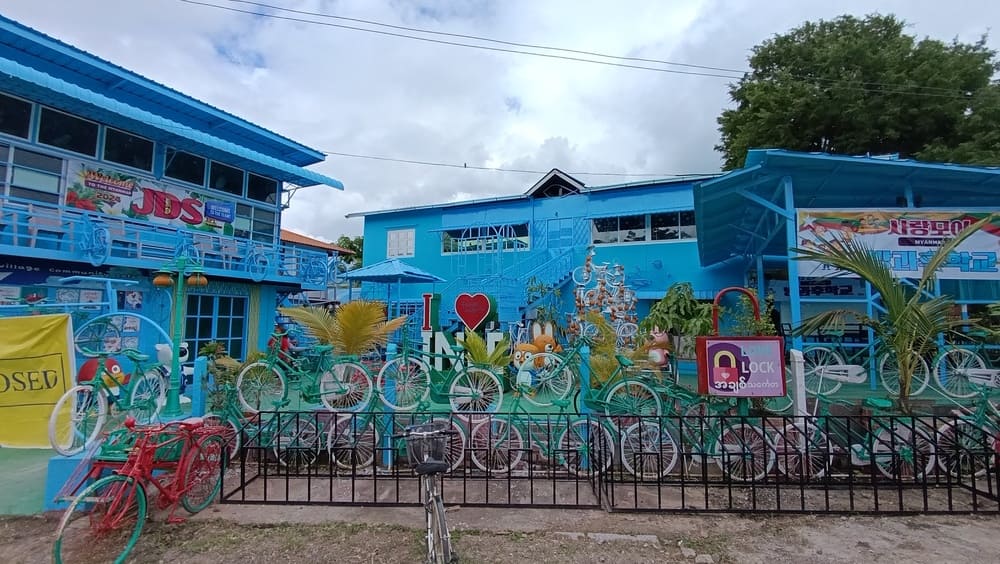
Back on the main road and a few kilometers further, you will see a cute Korean-themed cafe with metal art installations out in front.
On Google Maps it’s called “Korean Food & Cafe” while on Maps.me it features as either “Love Cafe” or “Locks of Love Community Cafe”. I myself love the last name.
It’s a social entrepreneurship enterprise with a portion of the profit going towards orphans.
I would’ve loved to grab a cup of coffee, but unfortunately, the cafe was closed. The 2 employees that came out made it seem like it was closed only on that particular day but I had a slight suspicion (and their poor English added to it) that it had been closed for a while due to the lack of visitors.
Red Mountain Wine Estate
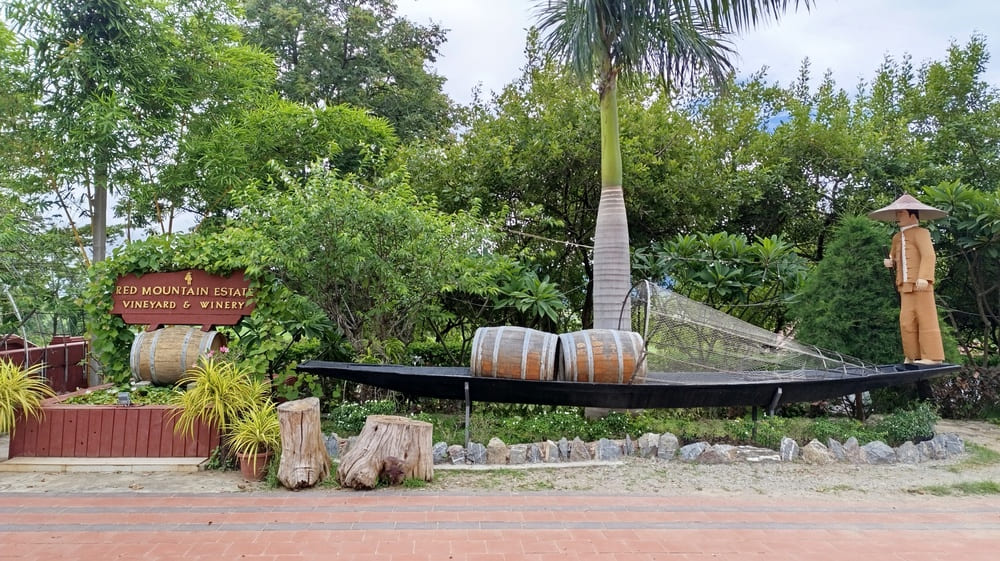
Inle Lake’s surrounding lands are fertile enough to produce some of the best wine in Myanmar. One of the most famous wineries is the Red Mountain Wine Estate [map].
Situated on a hill, about a 1 km detour right of the main road, the estate has a vintner, a restaurant and is surrounded by vineyards.
Before the pandemic, there used to be free tours and tasting sessions offered on the premises but when I arrived there was barely anybody. No more tours, though we were allowed to go around the vineyards by ourselves.
It’s free to enter and explore, though a bit dull without someone to tell you the story and explain.
Inside Nyaung Shwe
After nearly 30 km of cycling, you will be back in Nyaung Shwe. Depending on how much sunlight is left of the day, you can visit some places of interest inside the town.
Old Shan Palace (now Cultural Museum)

Inle Lake is inside Shan State, one of the constituent parts of the Union of Myanmar.
The Shan States used to have kings and queens, and royalty and a court of nobles, and a throne… It was one of the dominant polities in Burma up until the 20th century.
Shan’s last royal palace is in Nyaung Shwe. In the 1960s, the absolutely bat-shit-crazy dictator Ne Win (a different story) stripped the hereditary rights of the Shan State and transformed the palace into a Cultural Museum.
Today, for an entrance fee of 2000 MMK, you can explore cultural artifacts from Shan State and of course (like in Yangon’s National Museum) the old throne as well as royal attire and items of power.
The wooden interior is reportedly amazing, however, the museum was closed (seemingly permanently) so I couldn’t even go in past the gates outside.
Night Market
Finish off the day with a visit to the night market [map]. It’s not very big, perhaps 30 stalls and small eateries. I recommend you try the freshly grilled fish.
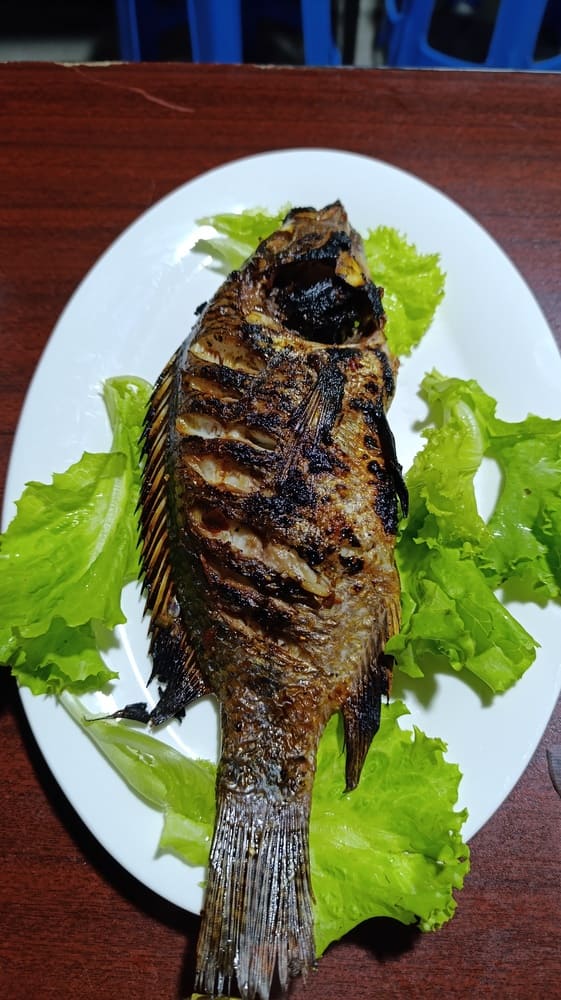
The morning after: Mingalar Market
An honorable mention goes to the central Nyaung Shwe Wet Market, also called the Mingalar Market.
It is one of the main markets in the region of Inle Lake, separate from the 5-day moving market.
There is literally everything at the market there, from clothes to fish, from spices to jewelry, from vegetables to traditional snacks and desserts.
Musings
With everything closed, was it even worth it to travel there, Simon?
To some extent, I wonder that myself. However, I believe this is a very egocentric look at the situation.
The places I couldn’t visit were not closed whimsically but due to protracted armed conflict. Well, not directly (this region was still pretty safe when I visited) but one thing leading to another, then to another…The chain of effect is long but real.
I have explored the ethics of traveling in Myanmar in detail, so let me be succinct: not traveling is one of the links in the chain of effect. Travel boycott does more harm than good, as evidenced by the closed businesses and ventures around Inle Lake. You traveling to Inle Lake directly supports those who need it the most, not the murderous junta.
As Mr. Yam pleaded: “Please tell people to come and visit me. We want them to come back.“
I don’t think there is any better tourism advertisement.
